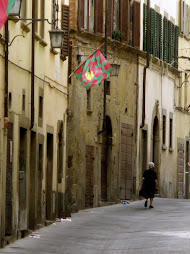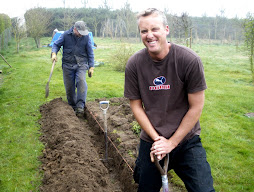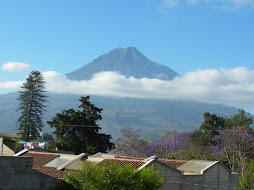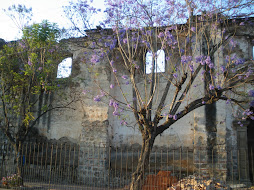A major goal for our travels this year is to improve our Spanish skills to at least an intermediate level. After almost 5 months living abroad in mostly Spanish speaking countries, we seem to be inching closer to that objective. This has been a feat I did not think possible at beginning the year.
To review, we began our travels with some of the basic skills we acquired in high school, and the few courses we took after college. Our two-week class in Madrid helped to get us off on the right foot, but was too short for any significant gains. Plus, the Spanish spoken in Spain is not completely practical due to the pronunciation and grammar differences from Latin American Spanish. Following the two weeks of class, we had occasional practice with locals, but no
further instruction and ultimately few gains. It would be another 3 months until we had the chance to get serious about our language development.
This was of course our month of class with Casa Xalteva in Granada, Nicarauga. Our four-hour a day class was by far the most significant time of growth for us. Trisha and I were both lucky to have intelligent and engaging teachers (Maria and Sergio) who made the process enjoyable. Along with our class, we had the Spanish practice in our home-stay and our daily interactions with people. The last formal instruction time for us was three weeks ago with Matagalpa tours. Our week of class was challenging due to our “intermediate book,” but not taught with the same degree of expertise as our previous school. So where does that leave us now?
Being relatively at the same level, Trisha and I can both use the past, present, and future tenses in Spanish with relative ease. Although we do not have mastery of all the different forms that come with these tenses, we feel fairly confident in the more common ones (simple present/present progressive, imperfect and indefinite past, simple future). Our verb memorization is progressing at the moment too, and we are adding to the supply of nouns and verbs in our minds. The most challenging element for us has been listening and understanding Spanish speakers. Trisha has an easier time in this area, as I need a few more seconds to process and translate what is being said. But it seems we are growing in this difficult area too. As for speaking, it is sometimes the easier phrases and sentences that can be the most difficult to use, as our study of those was further in the past. In general, the most challenging elements for us are using various pronouns correctly in conversation, recalling all feminine and masculine forms of words and articles, and applying all that we have memorized on paper to real-life circumstances. At least our progress has placed us in situations we previously thought unrealistic for this year.
One of the happiest results of our progress is being able to actually carry on conversations for long periods of time in Spanish. On Thursday for example, we were invited to have dinner with the woman who is renting her house to us. In the past, a meal spent with Spanish speakers was a laborious affair, with various degrees of success. This past Thursday was different, as the
dinner actually turned out to be highly enjoyable. The comprehension skills kicked in and we were really throwing together coherent sentences. We even made our host and her children laugh from time to time not because of our mistakes, but rather the content of what we were talking about.
Another Spanish “feel-good” moment was an interesting conversation we had with a woman at Centro Girosol, the adults with disabilities program in Matagalpa. The woman, Rosa, is very outgoing and friendly, but also hearing impaired. To communicate with us she had to use sign language, which required another person in the group to translate. The man translating was skilled in sign language and only spoke Spanish. So our conversation was Spanish translated to sign language. It was a simple conversation, but felt good as we were using our second language skills to communicate with a person who used another form of communication altogether. Our past experiences with translations have been all Spanish to English, so this felt like a big step up for us.
I think a final element that has added to our Spanish confidence is being able to approach and converse with people in the community. Possessing lower skills in Spain made conversing with a variety of people impossibility at times. It also provided for moments of confusion when asking for directions or changing parts of an order at a restaurant. Our problems have been fewer here and asking random things to random people has become more of a reality.
With that said, there are still days where frustration reigns and illogical and incomprehensible sentences fly out our mouths. For example, on Thursday night Trisha and I were taking a taxi back from a local bar. While chatting with the driver, Trisha asked the age of his toddler son, who was seated in the front seat. Instead of saying “cuantos años tiene su hijo” (how old is your son), she said “cuanto cuesta su hijo” (how much does your son cost). The driver chuckled a little and answered her question, knowing what she was really trying to say. But you get the picture of the mistakes that can occur.
For me the frustrating moments are when everything I have learned seems to elude me and I can only utter the basic sentences I knew before I left the United States. Equally frustrating is when Trisha appears to get the conversation and I am still stuck with translating the first few sentences in my mind. I often wish I could slow down the pace of the conversation, take a few minutes to run it through my head for translation, form a grammatically correct and witty response, and then wait patiently for the next phrase. Maybe someday.
For our current and future progress in Spanish, we have a few things lined up and in the works. Since we do not want to spend money on language classes right now, we have set up "intercambios" twice a week with two locals we met through Matagalpa tours. We spend 45 minutes speaking in Spanish and 45 in English, correcting each other as we go, so all involved benefit from the practice. Our Spanish is a little better than their English, but we don’t mind at all. We have also been able to arrange a free Spanish class with the academy we will be teaching at beginning Monday. If all promises are kept, we should have a one-hour class Monday through Thursday. Yeah!
For the future, we are planning on going to Guatemala for the month of March (travel tips anyone?). We want to spend two weeks in Antigua and two weeks in Quetzaltenango, which are both safe and highly recommended tourist destinations. Both cities are well known for their abundance of quality Spanish schools, so we are hoping to fit at least two weeks of class if possible. After that, our Spanish speaking countries will be no more for this trip (Italian anyone?) But Trisha and I are committed to really making this a life-long project: one because of the practicality of it, and two because it’s actually quite fun when you get to a certain level
To review, we began our travels with some of the basic skills we acquired in high school, and the few courses we took after college. Our two-week class in Madrid helped to get us off on the right foot, but was too short for any significant gains. Plus, the Spanish spoken in Spain is not completely practical due to the pronunciation and grammar differences from Latin American Spanish. Following the two weeks of class, we had occasional practice with locals, but no
further instruction and ultimately few gains. It would be another 3 months until we had the chance to get serious about our language development.
This was of course our month of class with Casa Xalteva in Granada, Nicarauga. Our four-hour a day class was by far the most significant time of growth for us. Trisha and I were both lucky to have intelligent and engaging teachers (Maria and Sergio) who made the process enjoyable. Along with our class, we had the Spanish practice in our home-stay and our daily interactions with people. The last formal instruction time for us was three weeks ago with Matagalpa tours. Our week of class was challenging due to our “intermediate book,” but not taught with the same degree of expertise as our previous school. So where does that leave us now?
Being relatively at the same level, Trisha and I can both use the past, present, and future tenses in Spanish with relative ease. Although we do not have mastery of all the different forms that come with these tenses, we feel fairly confident in the more common ones (simple present/present progressive, imperfect and indefinite past, simple future). Our verb memorization is progressing at the moment too, and we are adding to the supply of nouns and verbs in our minds. The most challenging element for us has been listening and understanding Spanish speakers. Trisha has an easier time in this area, as I need a few more seconds to process and translate what is being said. But it seems we are growing in this difficult area too. As for speaking, it is sometimes the easier phrases and sentences that can be the most difficult to use, as our study of those was further in the past. In general, the most challenging elements for us are using various pronouns correctly in conversation, recalling all feminine and masculine forms of words and articles, and applying all that we have memorized on paper to real-life circumstances. At least our progress has placed us in situations we previously thought unrealistic for this year.
One of the happiest results of our progress is being able to actually carry on conversations for long periods of time in Spanish. On Thursday for example, we were invited to have dinner with the woman who is renting her house to us. In the past, a meal spent with Spanish speakers was a laborious affair, with various degrees of success. This past Thursday was different, as the
dinner actually turned out to be highly enjoyable. The comprehension skills kicked in and we were really throwing together coherent sentences. We even made our host and her children laugh from time to time not because of our mistakes, but rather the content of what we were talking about.
Another Spanish “feel-good” moment was an interesting conversation we had with a woman at Centro Girosol, the adults with disabilities program in Matagalpa. The woman, Rosa, is very outgoing and friendly, but also hearing impaired. To communicate with us she had to use sign language, which required another person in the group to translate. The man translating was skilled in sign language and only spoke Spanish. So our conversation was Spanish translated to sign language. It was a simple conversation, but felt good as we were using our second language skills to communicate with a person who used another form of communication altogether. Our past experiences with translations have been all Spanish to English, so this felt like a big step up for us.
I think a final element that has added to our Spanish confidence is being able to approach and converse with people in the community. Possessing lower skills in Spain made conversing with a variety of people impossibility at times. It also provided for moments of confusion when asking for directions or changing parts of an order at a restaurant. Our problems have been fewer here and asking random things to random people has become more of a reality.
With that said, there are still days where frustration reigns and illogical and incomprehensible sentences fly out our mouths. For example, on Thursday night Trisha and I were taking a taxi back from a local bar. While chatting with the driver, Trisha asked the age of his toddler son, who was seated in the front seat. Instead of saying “cuantos años tiene su hijo” (how old is your son), she said “cuanto cuesta su hijo” (how much does your son cost). The driver chuckled a little and answered her question, knowing what she was really trying to say. But you get the picture of the mistakes that can occur.
For me the frustrating moments are when everything I have learned seems to elude me and I can only utter the basic sentences I knew before I left the United States. Equally frustrating is when Trisha appears to get the conversation and I am still stuck with translating the first few sentences in my mind. I often wish I could slow down the pace of the conversation, take a few minutes to run it through my head for translation, form a grammatically correct and witty response, and then wait patiently for the next phrase. Maybe someday.
For our current and future progress in Spanish, we have a few things lined up and in the works. Since we do not want to spend money on language classes right now, we have set up "intercambios" twice a week with two locals we met through Matagalpa tours. We spend 45 minutes speaking in Spanish and 45 in English, correcting each other as we go, so all involved benefit from the practice. Our Spanish is a little better than their English, but we don’t mind at all. We have also been able to arrange a free Spanish class with the academy we will be teaching at beginning Monday. If all promises are kept, we should have a one-hour class Monday through Thursday. Yeah!
For the future, we are planning on going to Guatemala for the month of March (travel tips anyone?). We want to spend two weeks in Antigua and two weeks in Quetzaltenango, which are both safe and highly recommended tourist destinations. Both cities are well known for their abundance of quality Spanish schools, so we are hoping to fit at least two weeks of class if possible. After that, our Spanish speaking countries will be no more for this trip (Italian anyone?) But Trisha and I are committed to really making this a life-long project: one because of the practicality of it, and two because it’s actually quite fun when you get to a certain level



































































































































































































































































































































































































































































































No comments:
Post a Comment